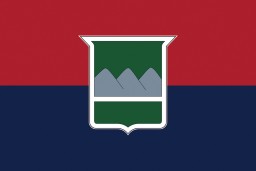You searched for: 【haigui.in】海归Returnees海归returnees加速器china加速器海归returnees加速器Is海归returnees加速器it海归returnees加速器a海归returnees加速器crime海归returnees加速器to海归returnees加速器use海归returnees加速器加速器?
<< Previous | Displaying results 51-100 of 2081 for "【haigui.in】海归Returnees海归returnees加速器china加速器海归returnees加速器Is海归returnees加速器it海归returnees加速器a海归returnees加速器crime海归returnees加速器to海归returnees加速器use海归returnees加速器加速器?" | Next >>
-
US troops land on Guadalcanal
PhotoUS troops land on Guadalcanal, in the Solomon Islands group. Guadalcanal was the focus of crucial battles in 1942–43. American victory in the Solomons halted the Japanese advance in the South Pacific. Guadalcanal, August 1942.

-
US troops landing on Guadalcanal
PhotoUS troops land on Guadalcanal, in the Solomon Islands groups. Guadalcanal was the focus of crucial battles in 1942–43. American victory in the Solomons halted the Japanese advance in the South Pacific. Guadalcanal, date uncertain.

-
Opening speech of the US prosecution at the International Military Tribunal
PhotoUS Chief Prosecutor Robert H. Jackson delivers the opening speech of the American prosecution at the International Military Tribunal. Nuremberg, Germany. November 21, 1945.
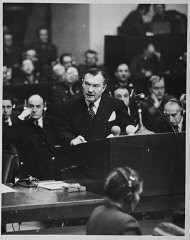
-
US Forces Liberate Flossenbürg
Timeline EventApril 23, 1945. On this date, US forces liberated the Flossenbürg camp in Germany.
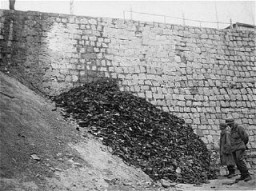
-
Identity Card Used in Hiding
Timeline EventAugust 3, 1943. On this date, Kurt I. Lewin was issued a forged ID card for "Roman-Paul Mytka." He used that identity to survive the war.
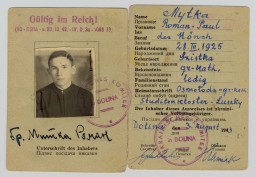
-
US Forces Liberate Buchenwald
Timeline EventApril 11, 1945. On this date, Buchenwald prisoners stormed the watchtower and seized control of the camp. US forces liberated the camp the same day.
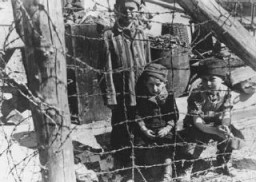
-
Map used as trial evidence
ArtifactThis map of the Treblinka I forced-labor camp was drawn by Holocaust survivor Manfred Kort in 1946. In 1990 Kort donated the map to the United States Holocaust Memorial Musem. In March 1997, at the request of the Office of Special Investigations, the Museum sent the original drawing to Chicago to be used as evidence at the trial of one Bronislaw Hajda. At the conclusion of Hajda's trial on April 10, 1997, the U.S. Department of Justice announced that "a federal judge in Chicago has revoked the naturalized…
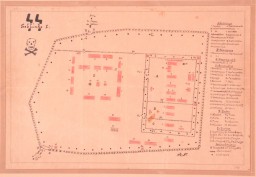
-
US soldiers view the bodies of prisoners in Ohrdruf
PhotoUS soldiers view the bodies of prisoners found in the newly liberated Ohrdruf concentration camp. Ohrdruf, Germany, April 6, 1945.
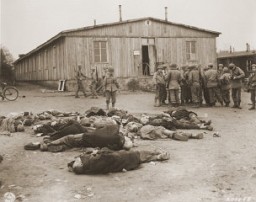
-
Two US soldiers cross the Rhine River
PhotoTwo American soldiers cross the Rhine River into Germany on March 29, 1945. In the foreground is Jack Caminer, who emigrated from Germany to the United States in 1938. After he was drafted into the US Army, Caminer was sent to Camp Ritchie to prepare for intelligence work. Caminer participated in the liberation of Ohrdruf.
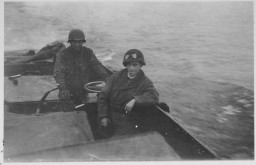
-
US troops view bodies of Wöbbelin victims
PhotoTroops of the American 82nd Airborne Division view bodies of inmates at Wöbbelin, a subcamp of the Neuengamme concentration camp. Germany, May 6, 1945.
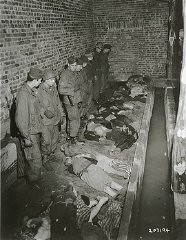
-
US generals view corpses of victims at Ohrdruf
PhotoGenerals Eisenhower, Patton, and Bradley view corpses of inmates at Ohrdruf, a subcamp of Buchenwald. Germany, April 12, 1945.
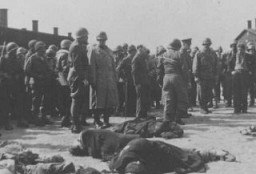
-
Resistance group in Buchenwald meets with US troops
PhotoMembers of a resistance organization in the camp meet with American soldiers in front of the entrance to the Buchenwald concentration camp. Buchenwald, Germany, after April 11, 1945. In early April 1945, as US forces approached the camp, the Germans began to evacuate some 28,000 prisoners from the main camp and an additional several thousand prisoners from the subcamps of Buchenwald. About a third of these prisoners died from exhaustion en route or shortly after arrival, or were shot by the SS. The…

-
Renovating the courtroom to be used for the International Military Tribunal
PhotoRepairs and improvements are made to the courtroom where the International Military Tribunal trial of war criminals would be held. The holes in the walls at the top (when completed) housed radio commentators and public address operators. September 11, 1945.
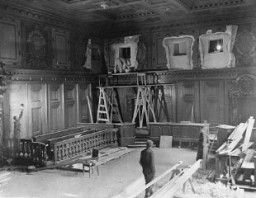
-
US condemnation of Kristallnacht
FilmOn November 9, 1938, the Nazis led a nationwide pogrom against Jews. During the pogrom, known as "Kristallnacht" (the "Night of Broken Glass"), bands of Storm Troopers (SA) destroyed thousands of Jewish-owned businesses and hundreds of synagogues. Almost 100 Jews were killed in the process. This footage shows scenes from a protest rally in New York City. Rabbi Stephen S. Wise voiced the outrage of the American Jewish community. As part of an official protest by the United States government against the…
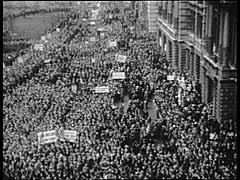
-
US soldiers during World War I
PhotoSurrounded by destruction, US soldiers of the 23rd Infantry fire a gun during World War I, 1918.
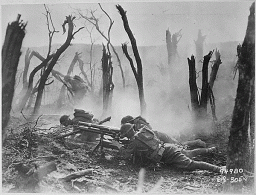
-
Flag graphic for US 103rd Infantry Division
PhotoA digital representation of the United States 103rd Infantry Division flag. The US 103rd Infantry Division (the "Cactus" division) was established in 1942. During World War II, they were involved in the Battle of the Bulge and captured the city of Innsbruck. The division also uncovered a Nazi subcamp attached to Kaufering camp complex. The 103rd Infantry Division was recognized as a liberating unit in 1985 by the US Army's Center of Military History and the United States Holocaust Memorial Museum…

-
Flag graphic for US 20th Armored Division
PhotoA digital representation of the United States 20th Armored Division's flag. The US 20th Armored Division was occasionally known as the "Armoraiders" during World War II. They participared in the liberation of the Dachau concentration camp. The 20th Armored Division was recognized as a liberating unit in 1985 by the United States Army Center of Military History and the United States Holocaust Memorial Museum (USHMM).
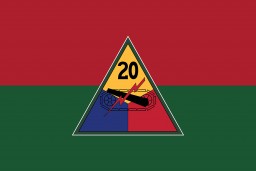
-
Flag graphic for US 4th Armored Division
PhotoA digital representation of the United States 4th Armored Division's flag. The US 4th Armored Division is also known as the "Breakthrough" division. During World War II, they were involved in the Battle of the Bulge and overran Ohrdruf, a subcamp of Buchenwald. The 4th Armored Division was recognized as a liberating unit in 1985 by the United States Army Center of Military History and the United States Holocaust Memorial Museum (USHMM).
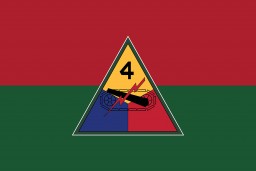
-
Flag graphic for US 63rd Infantry Division
PhotoA digital representation of the United States 63rd Infantry Division's flag. The US 63rd Infantry Division (the "Blood and Fire" division) was established in 1943. During World War II, they took the town of Heidelberg and liberated several Kaufering subcamps. The 63rd Infantry Division was recognized as a liberating unit in 2000 by the United States Army Center of Military History and the United States Holocaust Memorial Museum (USHMM).
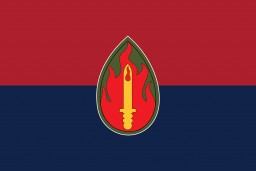
-
Flag graphic for US 6th Armored Division
PhotoA digital representation of the United States 6th Armored Division's flag. The US 6th Armored Division is also known as the "Super Sixth." During World War II, they were involved in the Battle of the Bulge and overran the Buchenwald concentration camp. The 6th Armored Division was recognized as a liberating unit in 1985 by the United States Army Center of Military History and the United States Holocaust Memorial Museum (USHMM).

-
Flag graphic for the US 101st Airborne Division
PhotoA digital representation of the United States 101st Airborne Division's flag. The US 101st Airborne Division (the "Screaming Eagles" division) was established in 1942. During World War II, they were involved in D-Day and the Battle of the Bulge. The division also captured the city of Eindhoven and uncovered the Kaufering IV camp. The 101st Airborne Division was recognized as a liberating unit in 1988 by the United States Army Center of Military History and the United States Holocaust Memorial Museum…

-
Flag graphic for US 26th Infantry Division
PhotoA digital representation of the United States 26th Infantry Division's flag. The US 26th Infantry Division (the "Yankee" division) was formed in 1917 and fought in World War I. During World War II, they were involved in the Battle of the Bulge and captured the city of Linz. The division also overran the Gusen concentration camp. The 26th Infantry Division was recognized as a liberating unit in 2002 by the United States Army Center of Military History and the United States Holocaust Memorial Museum…
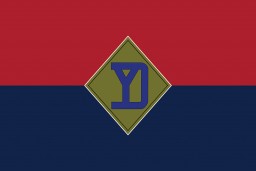
-
Flag graphic for US 36th Infantry Division
PhotoA digital representation of the United States 36th Infantry Division's flag. The US 36th Infantry Division (the "Texas" or "Lone Star" division) was established in 1917 and fought in World War I. During World War II, they were involved in the Allied invasions of North Africa and the Battle of the Bulge. The division also overran some of the Kaufering subcamps of the Dachau concentration camp. The 36th Infantry Division was recognized as a liberating unit in 1995 by the United States Army Center of…
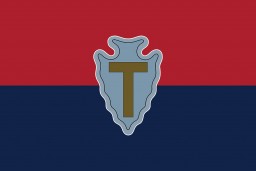
-
Flag graphic for US 42nd Infantry Division
PhotoA digital representation of the United States 42nd Infantry Division's flag. The US 42nd Infantry Division (the "Rainbow" division) was established in 1917 and fought in World War I. During World War II, they captured the cities of Würzburg, Schweinfurt, and Fürth. The division also entered the Dachau concentration camp. The 42nd Infantry Division was recognized as a liberating unit in 1985 by the United States Army Center of Military History and the United States Holocaust Memorial Museum…

-
Flag graphic for US 45th Infantry Division
PhotoA digital representation of the United States 45th Infantry Division's flag. The US 45th Infantry Division (the "Thunderbird" division) was established in 1924. During World War II, they were involved in the Allied invasions of North Africa and Italy, as well as the capture of the city of Nuremberg. The division also liberated the Dachau concentration camp. The 45th Infantry Division was recognized as a liberating unit in 1985 by the United States Army Center of Military History and the United States…
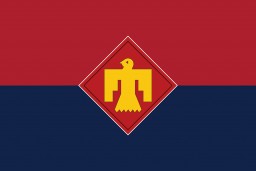
-
Flag graphic for US 71st Infantry Division
PhotoA digital representation of the United States 71st Infantry Division's flag. The US 71st Infantry Division (the "Red Circle" division) was established in 1943. During World War II, they were involved in taking the cities of Coburg, Bayreuth, and Regensburg. The division also liberated Gunskirchen, a subcamp of Mauthausen. The 71st Infantry Division was recognized as a liberating unit in 1988 by the United States Army Center of Military History and the United States Holocaust Memorial Museum (USHMM).

-
Flag graphic for US 82nd Airborne Division
PhotoA digital representation of the United States 82nd Airborne Division's flag. The US 82nd Airborne Division (the "All American" division) was established in 1918 and fought in World War I. During World War II, they were involved in D-Day and Battle of the Bulge. The division also overran Wöbbelin, a subcamp of Neuengamme. The 82nd Airborne Division was recognized as a liberating unit in 1991 by the United States Army Center of Military History and the United States Holocaust Memorial Museum (USHMM).
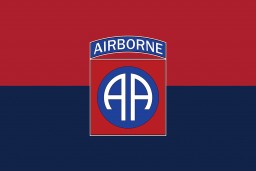
-
Flag graphic for US 84th Infantry Division
PhotoA digital representation of the United States 84th Infantry Division's flag. The US 84th Infantry Division (the "Railsplitter" division) was established in 1917. During World War II, they were involved in the Battle of the Bulge and captured the city of Hannover. The division also uncovered Hannover-Ahlem and Salzwedel, two satellite camps of the Neuengamme concentration camp. The 84th Infantry Division was recognized as a liberating unit in 1993 by the United States Army Center of Military History and…
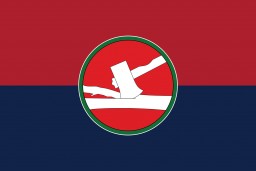
-
Flag graphic for US 89th Infantry Division
PhotoA digital representation of the United States 89th Infantry Division's flag. The US 89th Infantry Division (the "Rolling W" division) was established in 1917 and fought in World War I. During World War II, they captured the town of Eisenach and the city of Zwickau. The division overran Ohrdruf, a subcamp of Buchenwald. The 89th Infantry Division was recognized as a liberating unit in 1988 by the United States Army Center of Military History and the United States Holocaust Memorial Museum (USHMM).

-
Flag graphic for US 8th Infantry Division
PhotoA digital representation of the United States 8th Infantry Division's flag. The US 8th Infantry Division (the "Golden Arrow" or "Pathfinder" division) was established in 1918 and fought in World War I. During World War II, they captured the cities of Rennes and Brest. The division also encountered Wöbbelin, a subcamp of Neuengamme. The 8th Infantry Division was recognized as a liberating unit in 1988 by the United States Army Center of Military History and the United States Holocaust Memorial Museum…
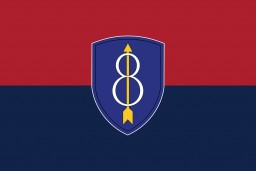
-
Flag graphic for US 90th Infantry Division
PhotoA digital representation of the United States 90th Infantry Division's flag. The US 90th Infantry Division (the "Tough Ombre" division) was established in 1917 and fought in World War I. During World War II, they were involved in D-Day and the Battle of the Bulge. The division also captured the city of Mainz and overran Flossenbürg concentration camp. The 90th Infantry Division was recognized as a liberating unit in 1985 by the United States Army Center of Military History and the United States…

-
Corpses found when US troops liberated Gusen
PhotoCorpses found when US troops liberated the Gusen camp, a subcamp of the Mauthausen concentration camp. Austria, after May 12, 1945.
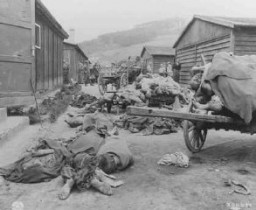
-
US soldiers view bodies of victims of Kaufering
PhotoUS soldiers view bodies of victims of Kaufering, a network of subsidiary camps of the Dachau concentration camp. Landsberg-Kaufering, Germany, April 30, 1945.
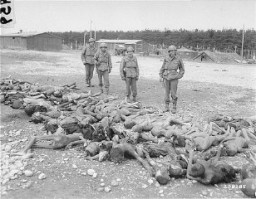
-
World War I US Army field hospital
PhotoA US army field hospital inside the ruins of a church in France during World War I. France, 1918

-
Survivors pose for a US Signal Corps photographer
PhotoFive Jewish survivors pose for a US Signal Corps photographer in front of Block 2 in the Hanover-Ahlem camp, a subcamp of Neuengamme. Hanover-Ahlem, Germany, April 11, 1945.
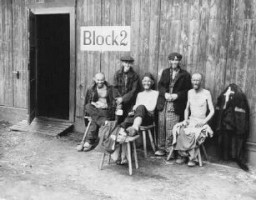
-
Eisenhower and other US Army officers inspect Ohrdruf
PhotoWhile on a tour of the newly liberated concentration camp, General Dwight Eisenhower and other high-ranking US Army officers view the bodies of prisoners who were killed during the evacuation of Ohrdruf. Ohrdruf, Germany April 12, 1945.
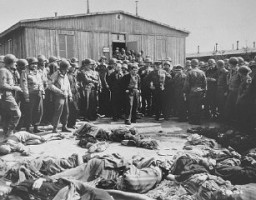
-
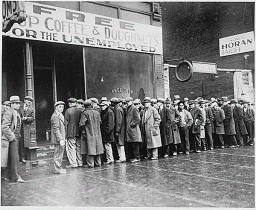
-
John Perry films US troops in Belgium
PhotoJohn Perry, a movie photographer with Unit 129, films GIs of the 290th Infantry Regiment, 75th Infantry Division, and 4th Cavalry Group ferreting out German snipers near Beffe, Belgium during the Battle of the Bulge. Twelve Germans were killed. The scene was photographed by Carmen Corrado of the 129th. January 7, 1945. US Army Signal Corps photograph taken by C.A. Corrado.

-
John Perry films US soldiers in Belgium
PhotoJohn Perry, a movie photographer with Unit 129, films GIs of the 290th Infantry Regiment, 75th Infantry Division, and 4th Cavalry Group ferreting out German snipers near Beffe, Belgium, in early January 1945. Twelve Germans were killed. The scene was photographed by Carmen Corrado of the 129th. January 7, 1945. US Army Signal Corps photograph taken by C.A. Corrado.
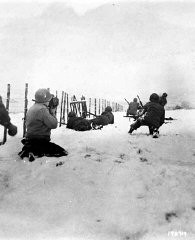
-
Flag graphic for US 104th Infantry Division
PhotoA digital representation of the United States 104th Infantry Division's flag. The US 104th Infantry Division (the "Timberwolf" division) was activated in 1942. During World War II, they captured the cities of Cologne and Halle. The division also overran Nordhausen and the Dora-Mittelbau concentration camp. The 104th Infantry Division was recognized as a liberating unit in 1988 by the United States Army Center of Military History and the United States Holocaust Memorial Museum (USHMM).
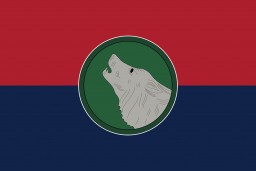
-
Flag graphic for US 10th Armored Division
PhotoA digital representation of the United States 10th Armored Division's flag. The US 10th Armored Division is also known as the "Tiger" division. During World War II, they captured the cities of Trier and Oberammergau. The division also overran a Dachau subcamp. The 10th Armored Division was recognized as a liberating unit in 1985 by the United States Army Center of Military History and the United States Holocaust Memorial Museum (USHMM).

-
Flag graphic for US 11th Armored Division
PhotoA digital representation of the United States 11th Armored Division's flag. The US 11th Armored Division (the "Thunderbolt" division) was formed in 1942. During World War II, they were involved in the Battle of the Bulge and captured the cities of Coburg, Bayreuth, and Linz. The division also overran the Mauthausen and Gusen concentration camps. The 11th Armored Division was recognized as a liberating unit in 1985 by the United States Army Center of Military History and the United States Holocaust…
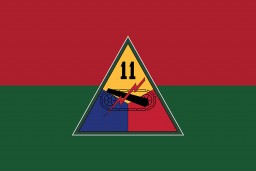
-
Flag graphic for US 12th Armored Division
PhotoA digital representation of the United States 12th Armored Division's flag. The US 12th Armored Divison is also known as the "Hellcats" division. During World War II, they captured the cities of Ludwigshafen and Würzburg. The division also overran a subcamp of Dachau. The 12th Armored Division was recognized as a liberating unit in 1988 by the United States Army Center of Military History and the United States Holocaust Memorial Museum (USHMM).
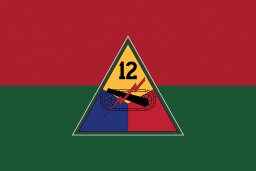
-
Flag graphic for US 29th Infantry Division
PhotoA digital representation of the United States 29th Infantry Division's flag. The US 29th Infantry Division (the "Blue and Gray" division) was established in 1917 and fought in World War I. During World War II, they were involved in D-Day, as well as the liberation of Dinslaken civilian labor camp. The 29th Infantry Division was recognized as a liberating unit in 1995 by the United States Army Center of Military History and the United States Holocaust Memorial Museum (USHMM).

-
Flag graphic for US 30th Infantry Division
PhotoA digital representation of the United States 30th Infantry Division's flag. The US 30th Infantry Division (the "Old Hickory" division) was established in 1917 and fought in World War I. During World War II, they were involved in the Battle of the Bulge and also liberated Weferlingen, a subcamp of Buchenwald. The 30th Infantry Division was recognized as a liberating unit in 2012 by the United States Army Center of Military History and the United States Holocaust Memorial Museum (USHMM).
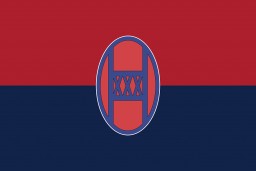
-
Flag graphic for US 3rd Armored Division
PhotoA digital representation of the United States 3rd Armored Division's flag. The US 3rd Armored Division (the "Spearhead" division) was established in 1941. During World War II, they were involved in the Battle of the Bulge and captured the city of Cologne. The division also discovered the Dora-Mittelbau concentration camp. The 3rd Armored Division was recognized as a liberating unit in 1985 by the United States Army Center of Military History and the United States Holocaust Memorial Museum (USHMM).
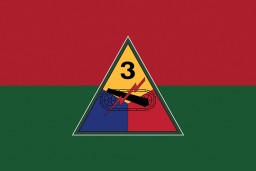
-
Flag graphic for US 4th Infantry Division
PhotoA digital representation of the United States 4th Infantry Division's flag. The US 4th Infantry Division (the "Ivy" division) was established in 1917 and fought in World War I. During World War II, they were involved in D-Day, the liberation of Paris, and the Battle of the Bulge. The division also captured the city of Nuremberg and discovered a Dachau subcamp near Haunstetten. The 4th Infantry Division was recognized as a liberating unit in 1992 by the United States Army Center of Military History and…

-
Flag graphic for US 65th Infantry Division
PhotoA digital representation of the United States 65th Infantry Division's flag. The US 65th Infantry Division (the "Battle Axe" division) was established in 1943. During World War II, they took the cities of Regensburg, Passau, and Linz. The division also overran a subcamp of the Flossenbürg concentration camp. The 65th Infantry Division was recognized as a liberating unit in 1994 by the United States Army Center of Military History and the United States Holocaust Memorial Museum (USHMM).
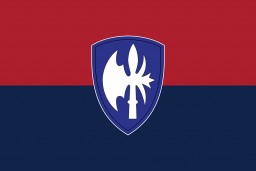
-
Flag graphic for US 69th Infantry Division
PhotoA digital representation of the United States 69th Infantry Division's flag. The US 69th Infantry Division ("Fighting 69th") was established in 1943. During World War II, they captured the city of Leipzig and uncovered Leipzig-Thekla, a subcamp of Buchenwald. The 69th Infantry Division was recognized as a liberating unit in 1993 by the United States Army Center of Military History and the United States Holocaust Memorial Museum (USHMM).

-
Flag graphic for US 80th Infantry Division
PhotoA digital representation of the United States 80th Infantry Division's flag. The US 80th Infantry Division (the "Blue Ridge" division) was established in 1917 and fought in World War I. During World War II, they were involved in the Battle of the Bulge. The division entered Buchenwald concentration camp and liberated Ebensee, a subcamp of Mauthausen. The 80th Infantry Division was recognized as a liberating unit in 1985 by the United States Army Center of Military History and the United States Holocaust…
